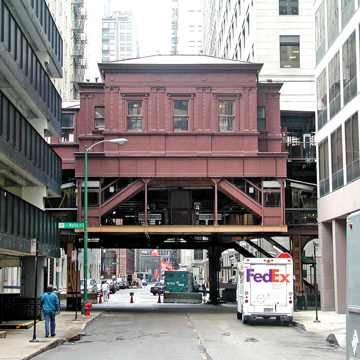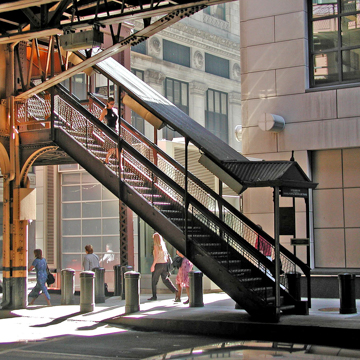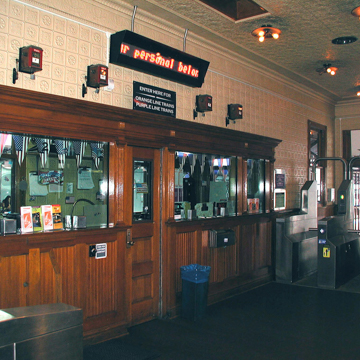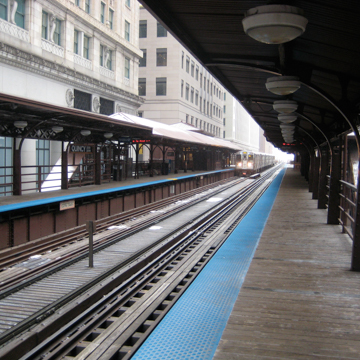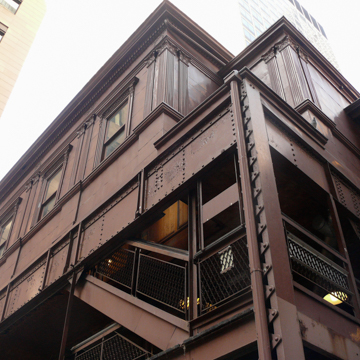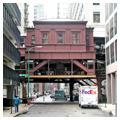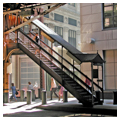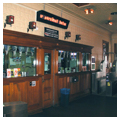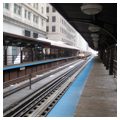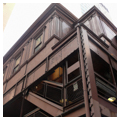You are here
Quincy Street Station
This above-street level structure, part of Chicago’s elevated rail transit system, is the best-surviving “L” station in the city’s downtown. It is also an excellent example of a railroad station designed in the Classical Revival style made fashionable by the 1893 World’s Columbian Exposition. Although several other “L” stations were built in this style, this is a rare example that has survived intact.
The Union Loop Elevated is one of the distinguishing features of Chicago’s downtown “Loop” commercial district. The massive steel “L” structure, which encircles the Loop on a two-mile path above four different downtown streets (Lake, Wabash, Wells, and Van Buren), was built in 1895–1897 as a key terminal and transfer point for four different private rapid transit companies.
The Quincy Street Station is built on steel girders above the intersection of Quincy and Wells streets. Stairs at each of the four corners lead to the station’s mezzanine-level walkway over the street, which connects to stairs leading to two separate track-level station houses and their platforms—each serving an elevated rail track heading in opposite directions.
The station houses, which have corrugated steel hipped roofs, are clad with painted sheet metal and ornamented with classical style details, including Corinthian pilasters, cartouches, window surrounds, and scrolled finials. The station house interiors feature wood doors and molding, pressed-tin walls, and tongue-in-groove wood wainscoting. Ticket agent booths face both the station interior and the exterior platform, which is covered by a steel-supported canopy with corrugated metal gable roofs and a pipe railing with ornamental, diamond inserts.
Alfred M. Hedley designed the Quincy Street Station, along with at least nine other stations along the Loop portion of the elevated system. Station platforms were lengthened between 1903 and 1913 and the various rail lines were merged into the Chicago Transit Authority in 1932. As a result, most of the other Loop “L” stations have either been demolished or severely altered in appearance.
The Quincy Street Station was restored to its original appearance in 1985–1988, as part of an intergovernmental agreement between the Chicago Transit Authority, the Illinois Historic Preservation Agency, and the U.S. Department of the Interior, after the “L” system became eligible for listing in the National Register of Historic Places.
References
Garfield, Graham. “Quincy.” Accessed May 5, 2017. www.Chicago-L.org.
Moffat, Bruce G. The “L”: The Development of Chicago’s Rapid Transit System, 1888-1932.Chicago: Central Electric Railfans’ Association, 1995.
Sande, Theodore Anton. Industrial Archeology: A New Look at the American Heritage. New York: Penguin Books, 1976.
Writing Credits
If SAH Archipedia has been useful to you, please consider supporting it.
SAH Archipedia tells the story of the United States through its buildings, landscapes, and cities. This freely available resource empowers the public with authoritative knowledge that deepens their understanding and appreciation of the built environment. But the Society of Architectural Historians, which created SAH Archipedia with University of Virginia Press, needs your support to maintain the high-caliber research, writing, photography, cartography, editing, design, and programming that make SAH Archipedia a trusted online resource available to all who value the history of place, heritage tourism, and learning.

















